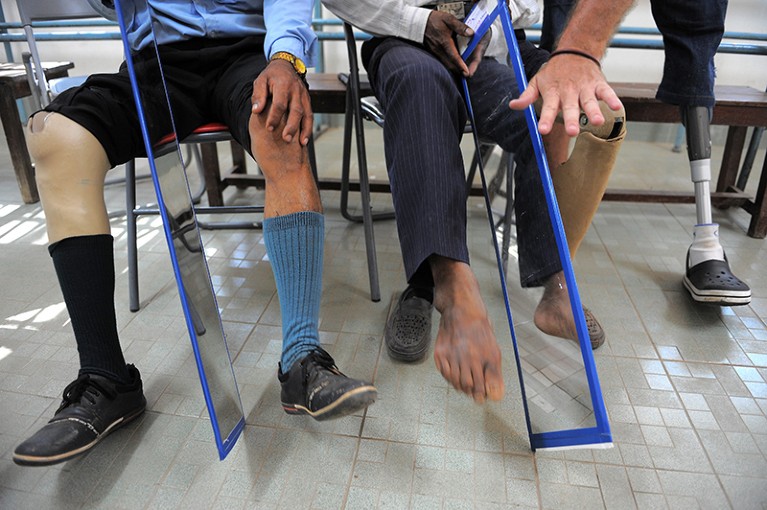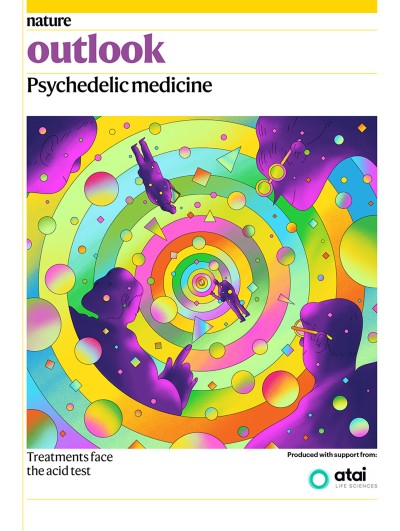Every day, James Close meets people who live with unrelenting, insurmountable chronic pain. A pain physical therapist and research fellow at Imperial College London, Close seeks to help people who have exhausted every treatment that specialists have to offer, and he sees their desperation to regain a semblance of a normal life — physically, emotionally and socially.
Across the Atlantic, Joel Castellanos, a pain medicine and rehabilitation physician at the University of California, San Diego (UCSD), asks his patients about their pain and how it interferes with their lives. He hears how their persistent pain wrenches away their ability to work, socialize and exercise.
Part of Nature Outlook: Psychedelic medicine
Looking for new therapeutic options, the two pain therapists have found themselves at the forefront of research exploring whether mind-altering psychedelic drugs might provide the relief that conventional analgesics cannot. Psychedelic medicines coupled with psychotherapy might “change the way we experience pain”, Castellanos says.
There is not much clinical evidence yet — just a smattering of findings across a handful of chronic pain conditions hinting at the possibility that psychedelics can alleviate persistent pain for weeks or months at a time. But a slew of pilot trials pitting psychedelics against chronic pain are starting to help the idea gain traction. These trials could provide the evidence to either establish psychedelics as a pain-relieving treatment or rule them out.
The trials build on numerous surveys and case studies that report profound reductions in the severity of cluster headaches, fibromyalgia and phantom-limb pain. Researchers are also leaning on tentative evidence suggesting that psychedelics can ease the depression that often accompanies chronic pain, and on decades-old reports that psychedelics can outperform opioid medications in managing cancer pain. “There is increasing recognition that psychedelics could be helpful in the treatment of chronic pain,” says Peter Hendricks, a clinical psychologist at the University of Alabama in Birmingham.
Despite the undeniable need for better pain relief, many pain researchers — including Close, Castellanos and Hendricks — are urging caution. Clear evidence that psychedelic therapies can quell pain is still lacking — indeed, psychedelics can sometimes worsen some people’s pain. Moreover, people with chronic pain are particularly vulnerable to hope and hype. “The potential is really grand,” Castellanos says. “But we have to do the work.”
Mechanisms of mitigation
There are several plausible biological mechanisms for how ‘classic’ psychedelic drugs, such as psilocybin and LSD, might relieve chronic pain. These powerful drugs bind the serotonin 5-HT2A receptor, which is integral to the central pain responses that go awry in chronic pain.
Studies in mice show that by activating 5-HT2A receptors, classic psychedelics dampen inflammation, which is a key driver of chronic pain, and upregulate genes involved in synaptic plasticity — the ability of the brain to strengthen, loosen and reorganize its connections, that could, in this case, rejig pain networks. In human brain-imaging studies, psychedelics seem to reset brain circuits that are perturbed in chronic pain or appear overactive in headache disorders1.
“We’re getting closer to seeing the rationale as to why psychedelics may be relevant in chronic pain,” says Bernadette Fitzgibbon, a neuroscientist who studies pain at Monash University in Melbourne, Australia. But researchers are a long way from joining the dots between the pharmacology of serotonergic psychedelics and their apparently rapid and transformative effects on the brain networks involved in pain. And they are not close to showing whether the drugs are effective analgesics.
Nevertheless, a few small clinical trials are building on anecdotal evidence that psychedelics provide a reprieve from searing cluster headaches, for which conventional medicines provide little relief. The effects are said to last months, or even years. Intriguingly, participants in these studies report pain relief even at low doses and without the mind-altering experience that underpins the way psychedelic-assisted therapies might attenuate depression and post-traumatic stress disorder.
The results from a double-blind, placebo-controlled trial of ten people who experience migraines — the first study of its kind — offer the first inkling that the anecdotal reports might stand up to clinical scrutiny. The study2, led by neurologist Emmanuelle Schindler at Yale University in New Haven, Connecticut, found that a single, low dose of psilocybin — small enough not to induce a trip — halved the number of days in which people experienced migraines, over a two-week period. “There’s nothing in headache medicine that can really do that,” says Schindler.
But long-term relief after a single psychedelic treatment is uncommon, and most people tend to report greater relief with multiple doses, Schindler says. She is running a follow-up migraine trial comparing two doses of psilocybin with one, as well as a longer, larger trial testing psilocybin against cluster headaches. In that randomized trial, which is similar to a study under way at the University Hospital of Basel in Switzerland, participants were given three doses of psilocybin (or a placebo) spaced five days apart; they then monitored their headaches and quality of life over the following two months. The results are forthcoming.
Cluster headaches, however, are a very different beast from migraine, even though both are paroxysmal disorders in which pain comes and goes. So, despite the early evidence, Schindler, like other trial investigators, stresses that psychedelics might not work in other types of chronic pain, or indeed for everyone.
Complex conditions
That reality has not deterred the researchers. Pain comes in many forms, and chronic pain conditions have unique features. But there are commonalities too, and it is here that the pain-relieving potential of psychedelics probably lies, although that remains to be tested. The unrelenting nature of chronic pain also presents a challenge quite unlike that of episodic headaches.
Nevertheless, a pilot trial currently under way at UCSD is testing the ability of psilocybin to treat phantom-limb pain — a quintessential neuropathic pain condition that Castellanos says serves as a good test case for the use of psychedelics.
Neuropathic pain is triggered when pain-sensing nerves are damaged or severed. For amputees with phantom-limb pain, excruciating pain seems to emanate from the limb that is no longer there. But psychedelics have, in some rare cases, completely eliminated phantom-limb pain when combined with therapies that use visual illusions to trick an amputee’s brain out of its pain.
In the randomized, triple-blind trial at UCSD, 30 amputees with phantom-limb pain will receive either two high doses of psilocybin or a placebo dose of niacin, chosen because it delivers some of the buzz people might get from psilocybin, but without evoking hallucinations. Psychotherapy sessions will help participants to prepare for and process their psychedelic experience, while functional brain imaging will look to see whether pain circuits are reorganized after treatment.

Mirror therapy that tricks the brain is used alongside psychedelics to treat phantom-limb pain.Credit: Tang Chin Sothy/AFP via Getty
It is thought that psychedelics might disrupt connections between resting-state brain networks that become ingrained as people ruminate on their pain or fixate on the ever-present threat of it coming back. Castellanos says that for people with persistent pain, their bodies are “practising experiencing pain every day”. Psychedelics might be able to reset those neural pathways.
But researchers doubt that psychedelics alone will provide relief. Chronic pain is influenced by a wide range of cognitive, emotional and social factors, layered on top of sensory and bodily cues. By removing people from their pain momentarily, psychedelics might trigger a transformative experience, providing an emotional shift that creates fertile ground for further therapy. But they will need to be paired with psychological and physical therapy because psychedelic drugs merely open a window, as Fitzgibbon puts it, for psychotherapy to provide sustained benefit.
Close suggests that, in the long run, combined therapies could ease pain that once seemed permanent by helping people to reframe the way they relate to their chronic condition or perceive persistent pain.
Focusing too much clinical research on using psychedelic drugs as analgesics, Close adds, also risks overlooking the psychological aspects of pain, such as depression and anxiety, which intensify the pain experience. “Looking at it just through a physiological lens does not help,” he says, especially when chronic pain is rooted in and exacerbated by social, cultural and political inequities. Those inequities feed into the complex web of cognitive, emotional and behavioural responses to chronic pain that overlap and interact to influence someone’s perception of it. A holistic approach to pain management is therefore needed, Close says.
This is especially true for fibromyalgia, a centralized pain disorder marked by widespread body pain and fatigue that worsens when people avoid movement. Fibromyalgia typifies central sensitization, whereby nerves in the brain and spinal cord misfire and cause pain in joints, muscles and tendons. Depression is more common with fibromyalgia than with other pain disorders, making it another interesting test case for psychedelic-assisted therapies.
Hendricks is embarking on a feasibility study to test whether psilocybin is an effective treatment for fibromyalgia. It’s not the only one: an open-label clinical trial led by Kevin Boehnke, a chronic-pain researcher at the University of Michigan in Ann Arbor, is underway, and Close is leading a third study at Imperial College London.
Hendricks’s trial is starting small, aiming to recruit 30 fibromyalgia patients and asking them to report changes in pain severity and other measures of quality of life over 3 months. Dextromethorphan, a drug with hallucinogenic effects similar to psilocybin, will be used as a placebo.
Meanwhile, Close’s study at Imperial will capture first-person accounts of people’s pain experience after taking psilocybin, and look for changes in brain activity and connectivity. Clearly, Hendricks says, there is a lot of enthusiasm around what psychedelic-assisted therapy could do for people with fibromyalgia. “But ultimately, we have to let the data do the talking.”
Tentative steps
Even if psychedelics cannot stop pain signals per se, researchers speculate — on the basis of limited evidence — that these drugs might still hold some potential to alleviate the depression and substance-use disorders that often accompany and exacerbate chronic pain. If so, that would “undoubtedly improve quality of life among people with chronic pain conditions”, says Hendricks. “There is room for improvements even without pain relief,” Close adds.
Multiple surveys and one longitudinal study3 of people who use illicit drugs have linked lifetime psychedelic use with lower incidence of opioid-use disorder. Some data also suggest that psilocybin and LSD could help treat addiction to nicotine and alcohol. What’s more, there is considerable physiological and neurological overlap between depression and chronic pain. Repetitive, ruminative thoughts and catastrophic thinking, in which people focus on bad outcomes, are key facets of both depression and chronic pain. Inflammation is another link between the two that extends to migraine, fibromyalgia, cancer-related pain and autoimmune diseases.
“These things are hardly separable,” says Frederick Barrett, a cognitive neuroscientist at Johns Hopkins University in Baltimore, Maryland. His brain-imaging studies have detected changes lasting up to one month4 after a single, high dose of psilocybin in two regions of the brain, the dorsolateral prefrontal cortex and the anterior cingulate cortex, that are linked to mood management, pain modulation and pain perception.
More from Nature Outlooks
Barrett is being careful not to overstate the potential of psychedelics to treat chronic pain; the evidence so far is nowhere near what’s needed, he says. But the clinical trials that are under way, he adds, are exactly the kind of tough test that researchers should be putting psychedelic therapies through as they carefully evaluate the potential benefits and risks. The next steps include working out in larger trials how often psychedelic medicines need to be delivered, at what dose, and what supportive care is needed for each chronic pain condition.
Understanding the obscure mechanisms by which psychedelics evoke such powerful and durable effects is another key research goal, and could yield fresh insights about existing pain-relief medications. “There’s potential to learn a lot about mechanisms of chronic pain, and what needs to happen centrally in the brain and spinal cord when patients get better — or when they don’t,” says Castellanos.
Even without fully elucidating the underlying mechanisms, the profound and lasting effects of psychedelics reported by some patients suggest that these drugs are not merely covering up the symptoms of pain disorders but targeting the root causes of chronic pain, Schindler says. And if headache disorders are anything to go by, she adds, relieving chronic pain might not always require a full-blown psychedelic experience, because low doses seem to be effective.
Researchers might be keen to validate anecdotal reports from people with pain, Close says, but they still need to design rigorous studies and be honest about the outcomes. Otherwise, he warns, if pilot trials are rushed, the risk is “you end up with a treatment that might help some people but we don’t know who they are, so you have lots of people trying it who it doesn’t help at all.”
Careful not to repeat the mistakes that led to the opioid epidemic, researchers are edging forwards, one small trial at a time. Perhaps in the near future, psychedelics could help some people to cast off or delve into their pain, re-engaging with their physical bodies, which they have long dissociated from, and begin at last to heal.



